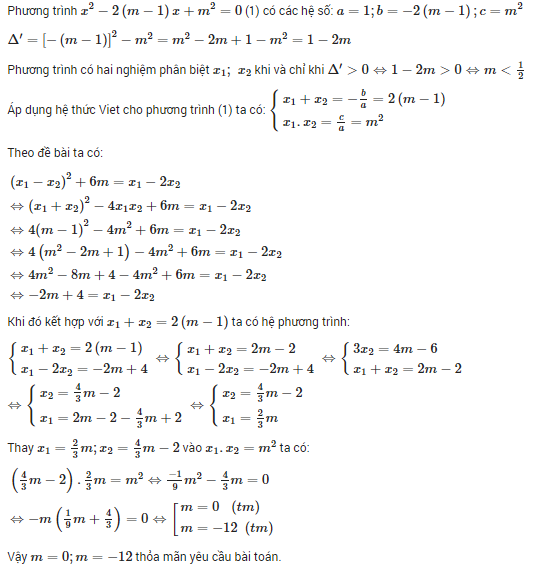Hãy nhập câu hỏi của bạn vào đây, nếu là tài khoản VIP, bạn sẽ được ưu tiên trả lời.

Để phương trình 1 có 2 nghiệm phân biệt
=> \(\Delta,>0\) <=> \(\left[-\left(m-1\right)\right]^2-\left(-2m+5\right)>0\)
<=>\(\left[{}\begin{matrix}m>2\\m< -2\end{matrix}\right.\)
=> Theo hệ thức Vi ét ta có
\(\left\{{}\begin{matrix}x_1+x_2=2\left(m-1\right)\circledast\\x_1.x_2=-2m+5\circledast\circledast\end{matrix}\right.\)
Theo bài ra ta có
\(x_1-x_2=-2\circledcirc\)
Từ \(\circledast vaf\circledcirc\) ta có hệ pt
\(\left\{{}\begin{matrix}x1+x2=2m-2\\x1-x2=-2\end{matrix}\right.\) <=>\(\left\{{}\begin{matrix}x1=m-2\\x2=m\end{matrix}\right.\)
Thay x1 và x2 vào \(\circledast\circledast\)ta dc
\(\left(m-2\right)m=-2m+5\)
<=> m=\(\left[{}\begin{matrix}-\sqrt{5}\\\sqrt{5}\end{matrix}\right.\left(tm\right)\)
Vậy ...

Lời giải:
Để pt có 2 nghiệm pb thì:
$\Delta'=1-(2-m)=m-1>0\Leftrightarrow m>1$
Áp dụng định lý Viet: \(\left\{\begin{matrix} x_1+x_2=2\\ x_1x_2=2-m\end{matrix}\right.\)
Khi đó:
$2x_1^3+(m+2)x_2^2=5$
$\Leftrightarrow 2x_1^3+(2x_1+2x_2-x_1x_2)x_2^2=5$
$\Leftrightarrow 2(x_1^3+x_2^3)+x_1(2-x_2)x_2^2=5$
\(\Leftrightarrow 2[(x_1+x_2)^3-3x_1x_2(x_1+x_2)]+x_1^2x_2^2=5\)
\(\Leftrightarrow 2[8-6(2-m)]+(2-m)^2=5\)
\(\Leftrightarrow m^2+8m-9=0\Leftrightarrow (m-1)(m+9)=0\)
Vì $m>1$ nên không có giá trị nào của $m$ thỏa mãn.

b: Δ=(-2m)^2-4(m^2-2m+2)
=4m^2-4m^2+8m-8=8m-8
Để pt có 2 nghiệm phân biệt thì 8m-8>0
=>m>1
x1^2+x2^2=x1+x2+8
=>(x1+x2)^2-2x1x2-(x1+x2)=8
=>(2m)^2-2(m^2-2m+2)-2m=8
=>4m^2-2m^2+4m-4-2m=8
=>2m^2+2m-12=0
=>m^2+m-6=0
=>(m+3)(m-2)=0
mà m>1
nên m=2

\(x^2-2\left(m-1\right)x+m^2-4=0\)
\(\Delta=b^2-4ac=\left[-2\left(m-1\right)\right]^2-4\left(m^2-4\right)\)
\(=4\left(m^2-2m+1\right)-4\left(m^2-4\right)\)
\(=4m^2-8m+4-4m^2+16\)
\(=-8m+20\)
Để pt đã cho có 2 nghiệm pb \(x_1,x_2\) thì \(\Delta>0\Leftrightarrow-8m+20>0\Leftrightarrow-8m>-20\Leftrightarrow m< \dfrac{5}{2}\)
Theo Vi-ét, ta có :
\(\left\{{}\begin{matrix}x_1+x_2=-\dfrac{b}{a}=2\left(m-1\right)\\x_1x_2=\dfrac{c}{a}=m^2-4\end{matrix}\right.\)
Ta có : \(x_1\left(x_1-3\right)+x_2\left(x_2-3\right)=6\)
\(\Leftrightarrow x_1^2-3x_1+x^2_2-3x_2=6\)
\(\Leftrightarrow\left(x_1^2+x_2^2\right)-3\left(x_1+x_1\right)-6=0\)
\(\Leftrightarrow\left(x_1+x_2\right)^2-2x_1x_2-3\left(x_1+x_2\right)-6=0\)
\(\Leftrightarrow\left(2m-2\right)^2-2\left(m^2-4\right)-3\left(2m-2\right)-6=0\)
\(\Leftrightarrow4m^2-8m+4-2m^2+8-6m+6-6=0\)
\(\Leftrightarrow2m^2-14m+12=0\)
\(\Leftrightarrow\left\{{}\begin{matrix}m=6\left(ktm\right)\\m=1\left(tm\right)\end{matrix}\right.\)
Vậy m = 1 thì thỏa mãn đề bài.

a: \(\text{Δ}=\left(-m\right)^2-4\left(m-1\right)=m^2-4m+4=\left(m-2\right)^2\)
để phương trình có hai nghiệm phân biệt thì m-2<>0
hay m<>2
Theo đề, ta có:
\(\left\{{}\begin{matrix}x_1+x_2=m\\x_1-x_2=5\\x_1x_2=m-1\end{matrix}\right.\Rightarrow\left\{{}\begin{matrix}2x_1=m+5\\x_2=x_1-5\\x_1x_2=m-1\end{matrix}\right.\)
\(\Leftrightarrow\left\{{}\begin{matrix}x_1=\dfrac{m+5}{2}\\x_2=\dfrac{m+5}{2}-5=\dfrac{m-5}{2}\\x_1x_2=m-1\end{matrix}\right.\)
\(\Leftrightarrow m^2-25=4m-4\)
\(\Leftrightarrow m^2-4m-21=0\)
=>(m-7)(m+3)=0
=>m=7 hoặc m=-3

a) Khi \(m=1\) thì pt đã cho trở thành \(x^2-2x-10=0\) (*)
pt (*) có \(\Delta'=\left(-1\right)^2-\left(-10\right)=11>0\)
Do đó (*) có 2 nghiệm phân biệt \(\left[{}\begin{matrix}x_1=\dfrac{-\left(-1\right)+\sqrt{11}}{1}=1+\sqrt{11}\\x_2=\dfrac{-\left(-1\right)-\sqrt{11}}{1}=1-\sqrt{11}\end{matrix}\right.\)
b) Xét pt đã cho \(x^2-mx-10=0\) \(\left(a=1;b=-m;c=-10\right)\)
Nhận thấy \(ac=1\left(-10\right)=-10< 0\) nên pt đã cho luôn có 2 nghiệm phân biệt \(x_1,x_2\).
Áp dụng hệ thức Vi-ét, ta có \(\left\{{}\begin{matrix}x_1+x_2=-\dfrac{-m}{1}=m\\x_1x_2=\dfrac{-10}{1}=-10\end{matrix}\right.\)
Ta có \(x_1^2+x_2^2=29\Leftrightarrow\left(x_1+x_2\right)^2-2x_1x_2=29\Leftrightarrow m^2-2\left(-10\right)=29\)\(\Leftrightarrow m^2+20=29\Leftrightarrow m^2=9\Leftrightarrow m=\pm3\)
Vậy để pt đã cho có 2 nghiệm phân biệt thỏa mãn đề bài thì \(m=\pm3\)

1:
\(\left\{{}\begin{matrix}\dfrac{2x+1}{x+1}+\dfrac{3y}{y-1}=1\\\dfrac{3x}{x+1}-\dfrac{4y}{y-1}=10\end{matrix}\right.\)
=>\(\left\{{}\begin{matrix}2-\dfrac{1}{x+1}+3+\dfrac{3}{y-1}=1\\3-\dfrac{3}{x+1}-\dfrac{4y-4+4}{y-1}=10\end{matrix}\right.\)
=>-1/(x+1)+3/(y-1)=1-2-3=-5 và -3/(x+1)-4/(y-1)=10-3-4=3
=>x+1=13/11 và y-1=-13/18
=>x=2/11 và y=5/18


\(\Delta=\left(-m\right)^2-2.1.\left(m-1\right)\\ =m^2-2m+1\\ =\left(m-1\right)^2\)
Phương trình có hai nghiệm phân biệt :
\(\Leftrightarrow\Delta>0\\ \Rightarrow\left(m-1\right)^2>0\\ \Rightarrow m\ne1\)
Theo vi ét :
\(\Leftrightarrow\left\{{}\begin{matrix}x_1+x_2=m\\x_1x_2=m-1\end{matrix}\right.\)
\(x^2_1+x^2_2=x_1+x_2\\ \Leftrightarrow x^2_1+x^2_2=m\\ \Leftrightarrow\left(x^2_1+2x_1x_2+x_2^2\right)-2x_1x_2=m\\ \Leftrightarrow\left(x_1+x_2\right)^2-2x_1x_2-m=0\\ \Leftrightarrow m^2-2\left(m-1\right)-m=0\\ \Leftrightarrow m^2-2m+2-m=0\\ \Leftrightarrow m^2-3m+2=0\\ \Leftrightarrow\left[{}\begin{matrix}m=1\left(loại\right)\\m=2\left(t/m\right)\end{matrix}\right.\)
Vậy \(m=2\)